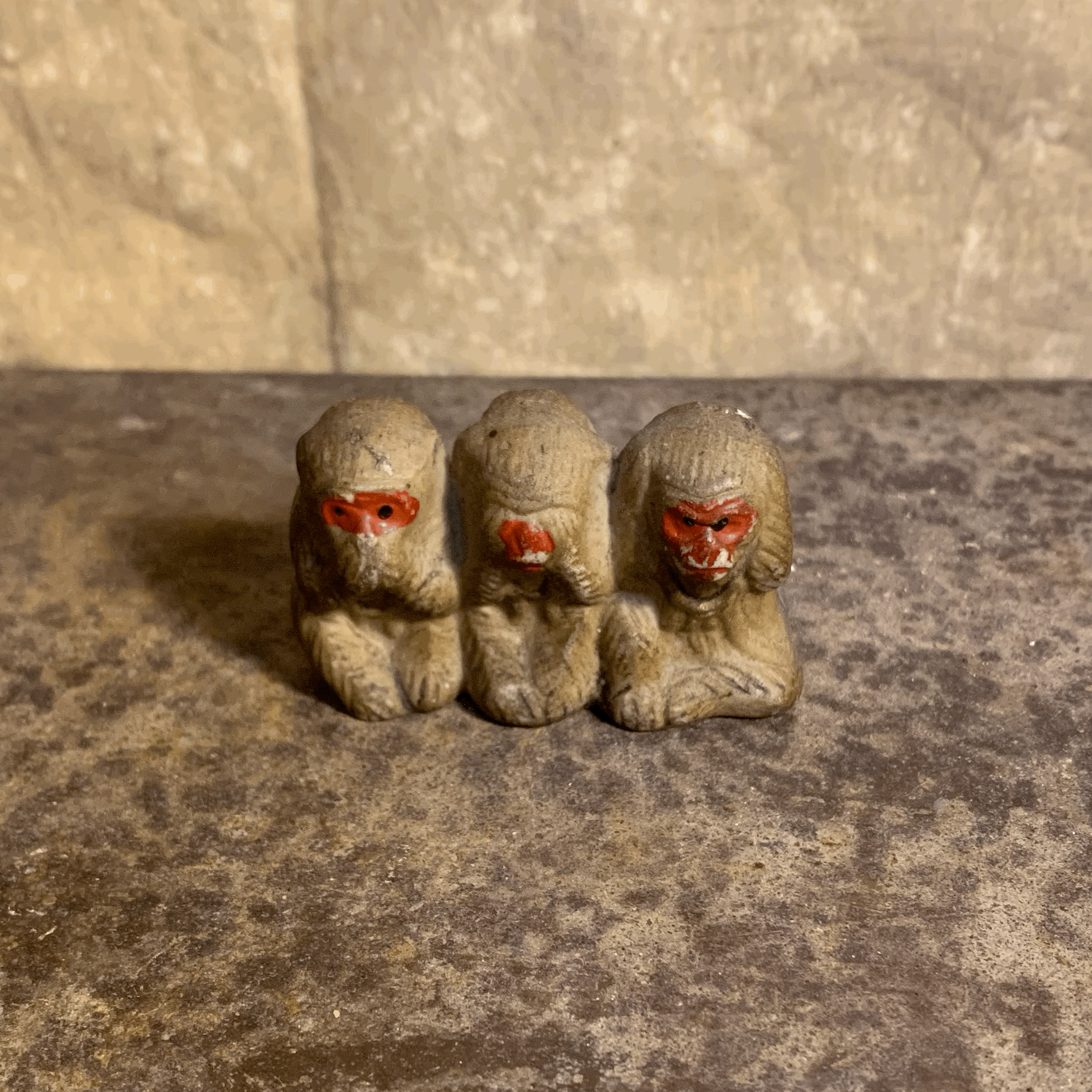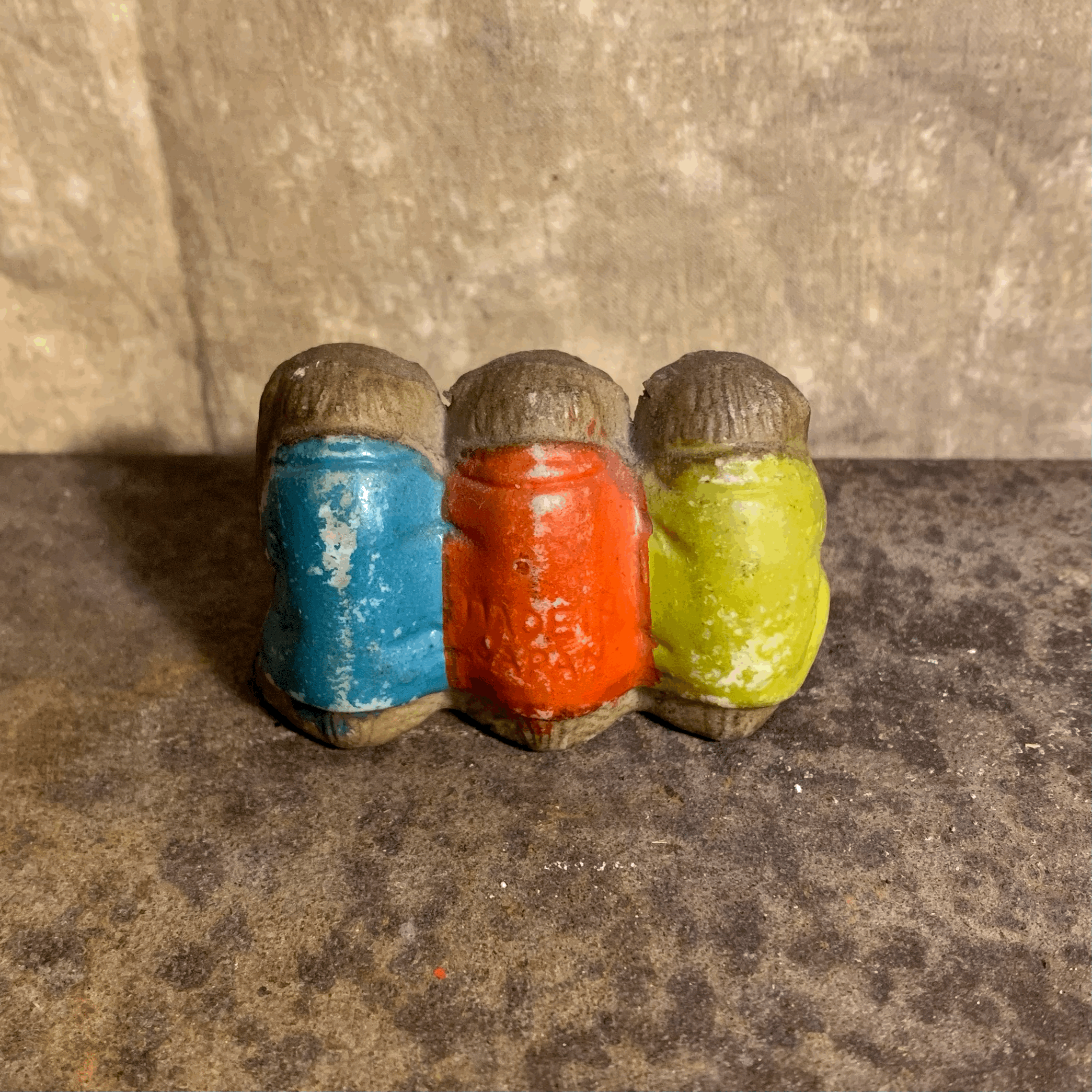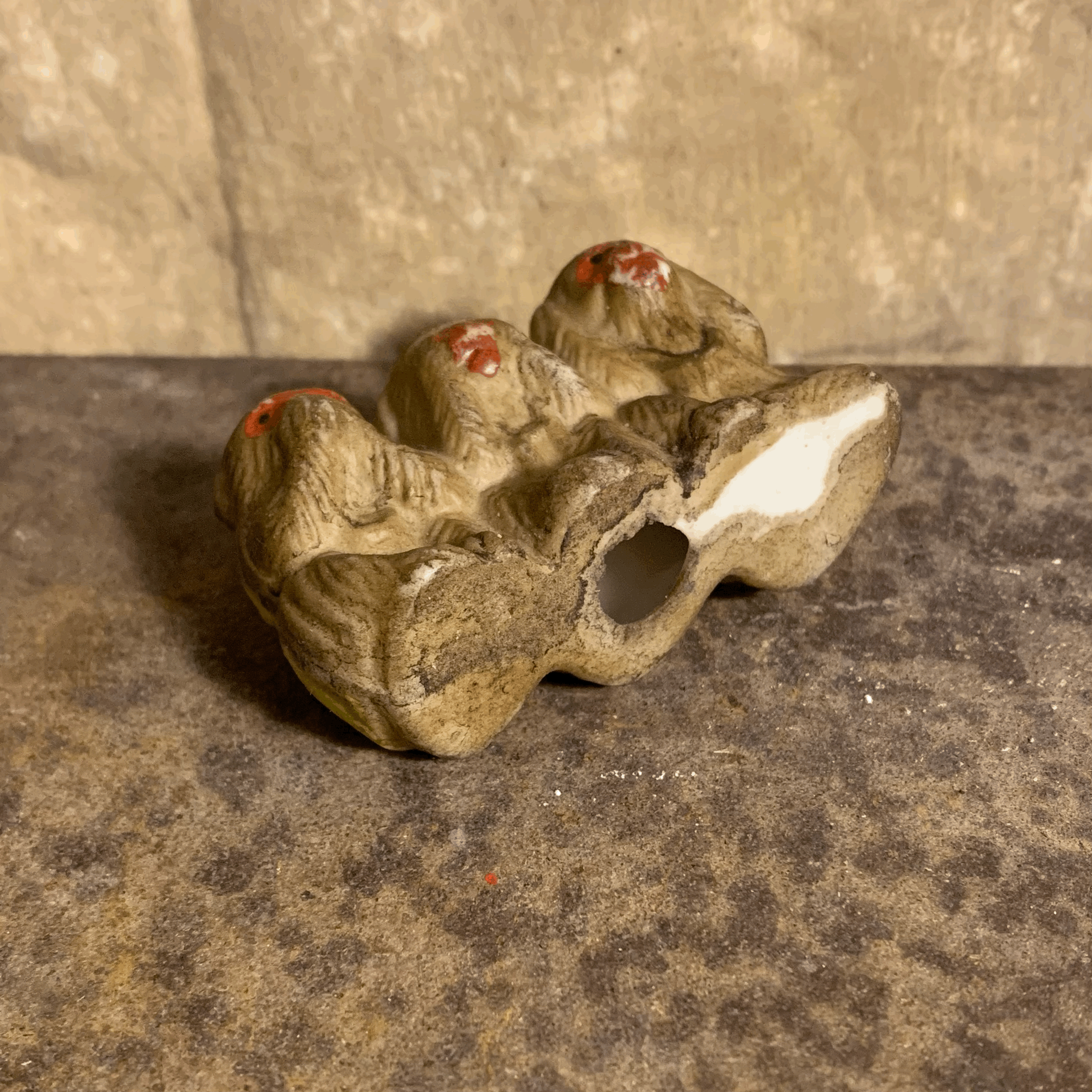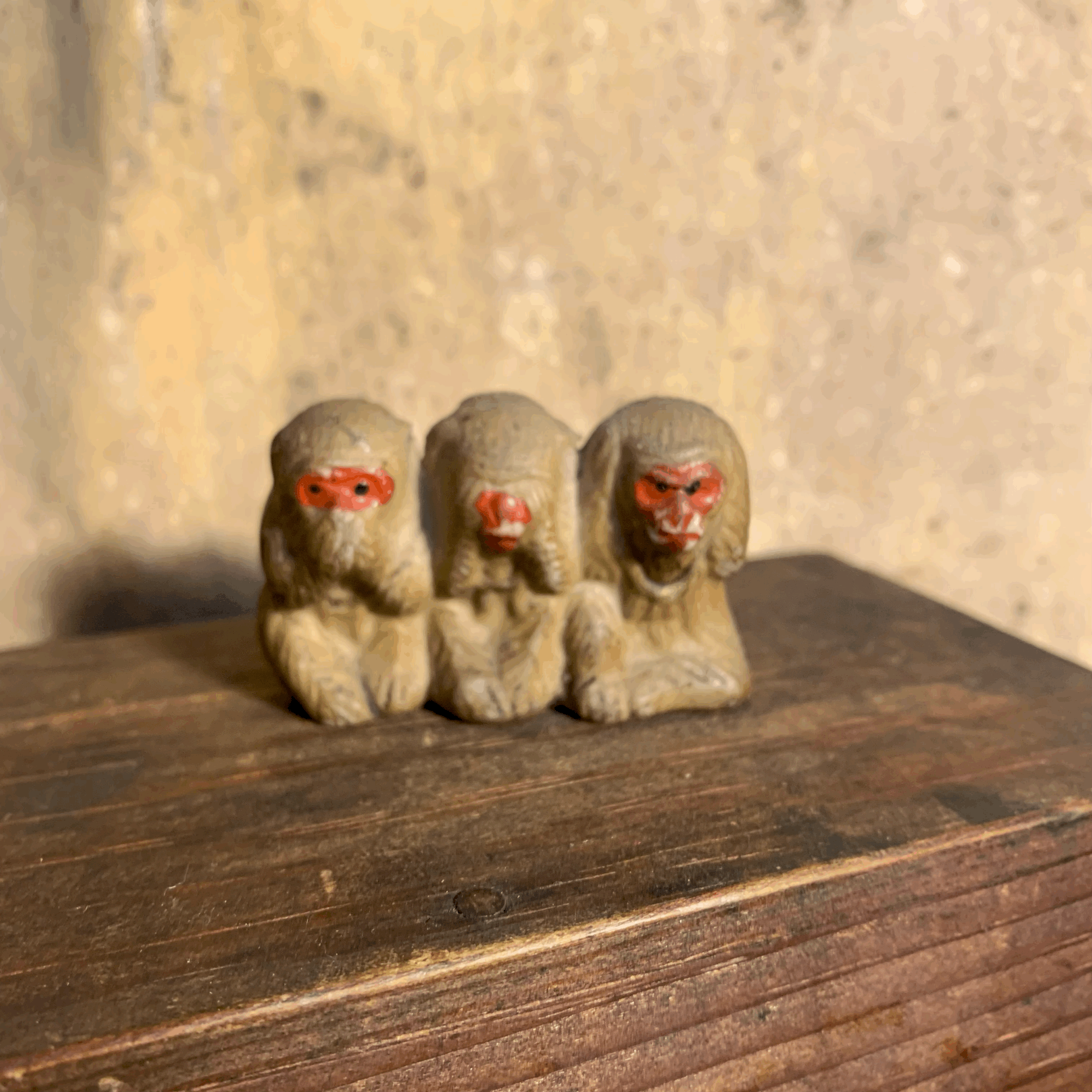 Image 1 of 4
Image 1 of 4

 Image 2 of 4
Image 2 of 4

 Image 3 of 4
Image 3 of 4

 Image 4 of 4
Image 4 of 4





Three Wise Monkeys
Here’s what this object is, because if it hasn’t become clear, that’s of almost no relevance in this “store”. It’s a tiny bisque depiction of Mizaru, Kikazaru, and Iwazaru, the three wise monkeys who hear no, see no, and speak no evil. They were made in Japan circa 1950 for export to the American market. These are not rare. This is an okay example of a common thing. I have a lot of these. Probably about 800. I really like them a lot. I think there’s a lot to say about these.
Occupied Japan. Has a real different ring depending on what you’re talking about. Take the words at face value and it’s the state of Japan post WWII. Under US control so as to prevent the Axis from gaining anything post war. Google it and you’ll see a bunch of cutesy grandma shit. It’s a bit more complicated than that of course, but the prolific Japanese ceramics foundries were largely converted into plants for tourist market items that would get sold along highways and train stops across the US in the 1940s and 1950s. A wildly productive market for odds and ends of a huge variety meant to serve the booming American tourist market.
The east and west differ quite a bit in the interpretation of what these monkeys stand for, and that stems largely from eastern versus western religious and philosophical traditions. The Japanese and Chinese interpretation of these leans towards the monkeys actively avoiding evil thoughts and actions, see no evil by not participating in evil. This is an active choice. This is being motivated to do and participate in good and taking the step to do what is necessary to only be involved in good and not evil. The western approach is more align with turning a blind eye towards evil. Ignore evil. Be passive towards evil. Evil lurks but just don’t look at it and you’ll be fine. This dichotomy feels similar to the two differing thoughts on how to hang your horseshoe. One camp believes that the opening should face up so that the shoe will “catch the luck”. The other camp flips it so that “the devil cannot build a nest”. Similarly, an active versus passive response to evil.
I do not believe in evil. I do not believe in the devil. But if given the chance to take an active or passive role in anything that will help others, the active option will always be the right move. I don’t always think about this sort of thing every time I see the many many many many wise monkeys that permeate every inch of my home. I mostly think they are cool. Eastern thinking being packaged into a cute thing in a roadside tourist shop during the economic boom of the 1950s, after a decade of packaging up Japanese Americans into prisons and slave labor. A small little bisque trinket. Surprisingly durable for being rather fragile. The active choice for the United States to demonize an entire population. The passive choice for millions to accept it. The active choice to use the most destructive weapon ever produced to completely alter a country and a people, likely forever. The passive choice to think these are cute reminders of 1950s prosperity. The way I think about them is a choice. I can passively think they are cool and enjoy that I’ve managed to find almost every variation that’s known and get excited when I find a new variation I haven’t seen. Or I can actively interrogate a massively complicated history that our country has with Japan. And with religion. And with how we use religion and power and control. I have a lot of these monkeys.
2.25”x1”x1.5”
Here’s what this object is, because if it hasn’t become clear, that’s of almost no relevance in this “store”. It’s a tiny bisque depiction of Mizaru, Kikazaru, and Iwazaru, the three wise monkeys who hear no, see no, and speak no evil. They were made in Japan circa 1950 for export to the American market. These are not rare. This is an okay example of a common thing. I have a lot of these. Probably about 800. I really like them a lot. I think there’s a lot to say about these.
Occupied Japan. Has a real different ring depending on what you’re talking about. Take the words at face value and it’s the state of Japan post WWII. Under US control so as to prevent the Axis from gaining anything post war. Google it and you’ll see a bunch of cutesy grandma shit. It’s a bit more complicated than that of course, but the prolific Japanese ceramics foundries were largely converted into plants for tourist market items that would get sold along highways and train stops across the US in the 1940s and 1950s. A wildly productive market for odds and ends of a huge variety meant to serve the booming American tourist market.
The east and west differ quite a bit in the interpretation of what these monkeys stand for, and that stems largely from eastern versus western religious and philosophical traditions. The Japanese and Chinese interpretation of these leans towards the monkeys actively avoiding evil thoughts and actions, see no evil by not participating in evil. This is an active choice. This is being motivated to do and participate in good and taking the step to do what is necessary to only be involved in good and not evil. The western approach is more align with turning a blind eye towards evil. Ignore evil. Be passive towards evil. Evil lurks but just don’t look at it and you’ll be fine. This dichotomy feels similar to the two differing thoughts on how to hang your horseshoe. One camp believes that the opening should face up so that the shoe will “catch the luck”. The other camp flips it so that “the devil cannot build a nest”. Similarly, an active versus passive response to evil.
I do not believe in evil. I do not believe in the devil. But if given the chance to take an active or passive role in anything that will help others, the active option will always be the right move. I don’t always think about this sort of thing every time I see the many many many many wise monkeys that permeate every inch of my home. I mostly think they are cool. Eastern thinking being packaged into a cute thing in a roadside tourist shop during the economic boom of the 1950s, after a decade of packaging up Japanese Americans into prisons and slave labor. A small little bisque trinket. Surprisingly durable for being rather fragile. The active choice for the United States to demonize an entire population. The passive choice for millions to accept it. The active choice to use the most destructive weapon ever produced to completely alter a country and a people, likely forever. The passive choice to think these are cute reminders of 1950s prosperity. The way I think about them is a choice. I can passively think they are cool and enjoy that I’ve managed to find almost every variation that’s known and get excited when I find a new variation I haven’t seen. Or I can actively interrogate a massively complicated history that our country has with Japan. And with religion. And with how we use religion and power and control. I have a lot of these monkeys.
2.25”x1”x1.5”
Here’s what this object is, because if it hasn’t become clear, that’s of almost no relevance in this “store”. It’s a tiny bisque depiction of Mizaru, Kikazaru, and Iwazaru, the three wise monkeys who hear no, see no, and speak no evil. They were made in Japan circa 1950 for export to the American market. These are not rare. This is an okay example of a common thing. I have a lot of these. Probably about 800. I really like them a lot. I think there’s a lot to say about these.
Occupied Japan. Has a real different ring depending on what you’re talking about. Take the words at face value and it’s the state of Japan post WWII. Under US control so as to prevent the Axis from gaining anything post war. Google it and you’ll see a bunch of cutesy grandma shit. It’s a bit more complicated than that of course, but the prolific Japanese ceramics foundries were largely converted into plants for tourist market items that would get sold along highways and train stops across the US in the 1940s and 1950s. A wildly productive market for odds and ends of a huge variety meant to serve the booming American tourist market.
The east and west differ quite a bit in the interpretation of what these monkeys stand for, and that stems largely from eastern versus western religious and philosophical traditions. The Japanese and Chinese interpretation of these leans towards the monkeys actively avoiding evil thoughts and actions, see no evil by not participating in evil. This is an active choice. This is being motivated to do and participate in good and taking the step to do what is necessary to only be involved in good and not evil. The western approach is more align with turning a blind eye towards evil. Ignore evil. Be passive towards evil. Evil lurks but just don’t look at it and you’ll be fine. This dichotomy feels similar to the two differing thoughts on how to hang your horseshoe. One camp believes that the opening should face up so that the shoe will “catch the luck”. The other camp flips it so that “the devil cannot build a nest”. Similarly, an active versus passive response to evil.
I do not believe in evil. I do not believe in the devil. But if given the chance to take an active or passive role in anything that will help others, the active option will always be the right move. I don’t always think about this sort of thing every time I see the many many many many wise monkeys that permeate every inch of my home. I mostly think they are cool. Eastern thinking being packaged into a cute thing in a roadside tourist shop during the economic boom of the 1950s, after a decade of packaging up Japanese Americans into prisons and slave labor. A small little bisque trinket. Surprisingly durable for being rather fragile. The active choice for the United States to demonize an entire population. The passive choice for millions to accept it. The active choice to use the most destructive weapon ever produced to completely alter a country and a people, likely forever. The passive choice to think these are cute reminders of 1950s prosperity. The way I think about them is a choice. I can passively think they are cool and enjoy that I’ve managed to find almost every variation that’s known and get excited when I find a new variation I haven’t seen. Or I can actively interrogate a massively complicated history that our country has with Japan. And with religion. And with how we use religion and power and control. I have a lot of these monkeys.
2.25”x1”x1.5”